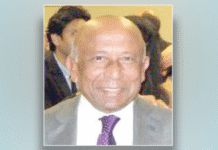At an intersection in Brooklyn, Bangladeshi immigrants take some of their first steps toward new lives. Where Church and McDonald Avenues meet, the scent of milky tea fills the air, and Bengali is more common than English.
For decades, construction work was a primary trade in Kensington’s Bangladeshi community. But the once-familiar morning rumble of contractor vans now gives way to the afternoon whirl of e-bikes making deliveries.
In the evenings, groups of men leave their crowded, subdivided apartments for adda, an informal gathering to catch up, often with snacks and tea.
Since the early 1970s, Bangladeshi immigrants have expanded their footprint with businesses, newfound political influence and places to worship. For many, the city now feels like home.
Dawn to Dusk on the Corner Where Bangladeshi Brooklyn Gathers
In “Little Bangladesh,” a growing community embraces tradition, and adapts to new trends.
Jonah Markowitz, Karen Zraick and
The photographer Jonah Markowitz spent more than two years immersed in the Bangladeshi community of Kensington, Brooklyn for this project, and was joined in the reporting and writing process by Karen Zraick and Samira Asma-Sadeque.
The number of Bangladeshis in New York City has nearly tripled over the last decade to more than 100,000. New communities dot the city, and their growth has helped make Asians the fastest-growing racial group in the city, according to the latest census data.
In Brooklyn last October, a corner in the neighborhood of Kensington became one of a handful of places officially given the name “Little Bangladesh.” There, the intersection of Church and McDonald has become a beacon for newly arrived Bangladeshis — a jumping-off point where newcomers can find apartments, jobs and friends.
“Everybody is coming here for socializing, but also to think about the next day,” said Sohel Mahmud, 54, a Bangladeshi journalist who runs ProbasiTV, an online news site covering the diaspora, out of a rowhouse a few steps away.

























Young Bangladeshi Americans are making inroads into politics, most notably with the election of Shahana Hanif, a daughter of Kensington, to the City Council in 2021. Ms. Hanif’s victory, at age 30, made her the first woman to represent the district, as well as the first Muslim woman and one of the first two South Asians on the council.
It was Ms. Hanif who requested the intersection’s new name. She also co-sponsored a resolution to make Feb. 21 Mother Language Day, in tandem with a holiday in Bangladesh commemorating protesters who fought for Bengali as a state language in the 1950s, when the area was part of Pakistan.
Ms. Hanif’s family history illustrates how Bangladeshi Kensington came to be. Her father arrived in the early ’80s and worked his way up in construction and restaurants, and came to own a local mainstay, Radhuni Sweets & Restaurant, which is now run by others.
Her experiences in the neighborhood drove her to make sure that all members of the community feel welcome in its public spaces. While the corner is often a male-dominated space, she and other Bangladeshi American women have carved out their own places there.
“I grew up like, ‘Wear a shawl over your chest, look down.’ There was a script,” Ms. Hanif said. “And I think many of us did not follow that script and pursued our own paths in an interesting, unique way.”
In recent years, Bangladeshis have come to the United States, as so many other migrants, after a perilous journey through Latin America. Some hope to apply for asylum; some are looking for a way to earn money to send home; some simply seek a better life.
Many of the Bangladeshis in Kensington hail from rural areas around the Bay of Bengal: Noakhali, Chittagong and Sandwip. Among them is Mir Hossain, 47. He arrived five years ago, after he said he was attacked for his political allegiances.
Mr. Hossain found the building blocks of his new life on the corner in Kensington, drawing on his years of experience in metalwork.
Mr. Hossain crossed through 19 countries on his monthslong journey to Brooklyn. He flew from the Middle East to South America and then trekked on foot through the Darién Gap, which divides Colombia and Panama, picking up work along the way when he could.
His bet seems to be paying off. He received asylum, and then a green card. He landed his apartment and jobs through connections he made on the corner, and went from day laborer to subcontractor. Now he picks up other workers from the corner in his Ford F-150 truck.
But still, something is missing. His wife and two children remain in Dhaka. He hopes they will be able to join him in Brooklyn soon.
“I don’t sleep well,” he said. “I miss my family.”
Kensington’s gathering spaces have also become crucial networking opportunities for the growing number of young Bangladeshi men working for food delivery apps like Seamless and DoorDash, a path that became more lucrative during the pandemic.
Many deliverymen zip around wealthier areas like nearby Park Slope during the dinner rush, and then head to Kensington for their own meals.
Working for the apps can offer more flexibility than construction. But the potential for danger is constant: accidents, terrible weather and crime, all without the protections offered by steady employment.
In October 2021, a Bangladeshi deliveryman named Sala Miah was fatally stabbed during a robbery at a Manhattan park where he had stopped to rest after a long shift. Mr. Miah’s funeral was held at one of several Bangladeshi mosques in Kensington. He was 51.
Rubel Uddin’s younger brother, Tarek Aziz, was killed in 2021 when he hit a patch of gravel while riding his scooter delivering a late order. It was hot out the day of the accident, and he wasn’t wearing a helmet.
“In our life we are being tested,” said Mr. Uddin, who is 34. “Everything is temporary.”
When his mother calls from Bangladesh, she begs her son to stop doing delivery work.
Although Mr. Uddin remains deeply depressed about his brother’s death, he has continued because he needs the income. He uses a car now instead of a moped.
Mr. Uddin lives with six other men in a three-bedroom apartment in East New York crowded with plants that remind him of the verdant village he left a decade ago. His roommates work delivery, drive taxis or do construction, and they all pay rent to a fellow Bangladeshi who owns the building.
They do their shopping in Kensington, as well as Bangladeshi shops in Jackson Heights and Ozone Park, and he appreciates the sense of community. But he is weighing his limited options, and considering leaving New York.
Others also still dream of home. Motiul, 54, who asked that his last name not be used because of his legal status, arrived in New York as a cargo ship crewman in 2018 with $100 in his pocket. He headed straight to the home of a Bangladeshi friend in Kensington, and he stayed after his short-term visa expired.
His story harks back to some of the earliest Bangladeshis in New York, who came in the 1920s as “ship jumpers,” men who worked on ships and stayed in the city once they docked here.
These days, Motiul mostly renovates building exteriors, working on scaffolding on high floors, which can net him as much as $350 a day. He also traveled to Philadelphia to work for a Bangladeshi contractor there. But work is excruciatingly slow — sometimes only a couple of days a month — and the cost of living is high.
His mind is back in his small town in the Jessore District, where renovations are underway on his family home. He oversees the process from afar, instructing workers in the brick-pointing techniques he has learned in New York. His wife and three grown children have urged him to return.
“They say I have done enough for them,” he said.
Some women in the community are pushing to create new opportunities for themselves, but also to preserve their language and culture, especially for Bangladeshi children growing up in a diverse, fast-moving city.
Farojan Saeed, 28, moved to New York in 2016 to join her husband, Syed Rehan, who works in technology.
Now Ms. Saeed teaches dance at a local public school and at the Bangladesh Institute of Performing Arts, which promotes Bengali arts and language and holds classes in the neighborhood. She also works as an intake coordinator for a home health care company.
Her husband has been living for more than 20 years in the same small apartment in Kensington, which they now share with his parents.
Ms. Saeed wants to buy a house, but real estate in Kensington has become far too expensive. She is considering Jamaica, Queens, where the performing arts institute has another outpost.
Annie Ferdous helped found the Bangladesh Institute of Performing Arts in the early ’90s. She is trying to carve out a space inside a conservative culture where dance is often frowned upon. Some see it as incompatible with their interpretation of Islam.
Ms. Saeed also faced opposition as she was growing up, from relatives on her mother’s side who frowned upon dance. But her father pushed for her to be allowed to pursue her art, which she calls her first love.
With other public spaces so dominated by men, Ms. Ferdous sees it as vital that women gather to keep their traditions alive. She calls it “constructive adda.”
“Those of us who can, if we lead the path and move forward, then a few others will think, ‘Let me also, we have a space,’” she said.
The neighborhood buzzed at the end of Ramadan, as Bangladeshis from around the city gathered to worship, do charitable works and break their fasts each night. The faithful filled nearly a whole block of McDonald Avenue during Eid al-Fitr.
Mr. Mahmud, the journalist, was among them. As men greeted one another with warm hugs after the service, he said it felt like home.
The videos were filmed using a Phantom high-speed camera, which creates an ultra-slow-motion effect by recording up to 1,000 frames per second.
Asmaa Elkeurti contributed research.
Produced by Jeffrey Furticella.












